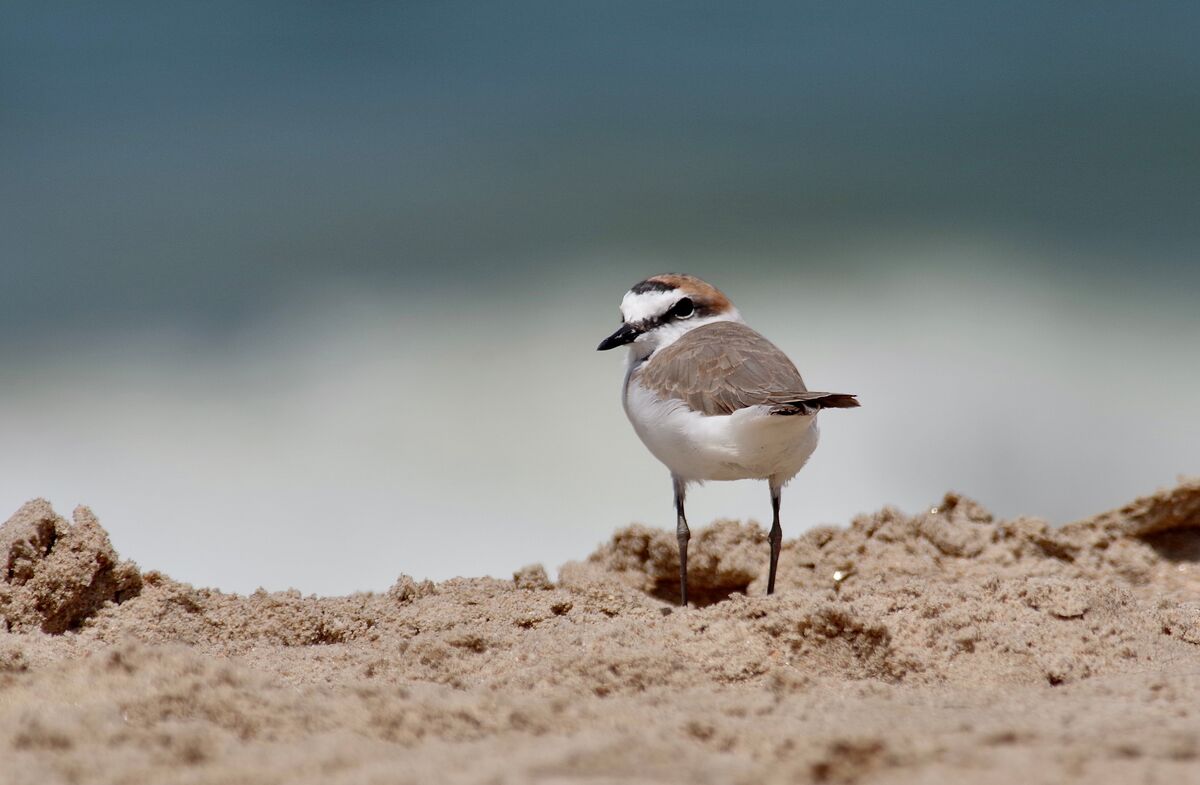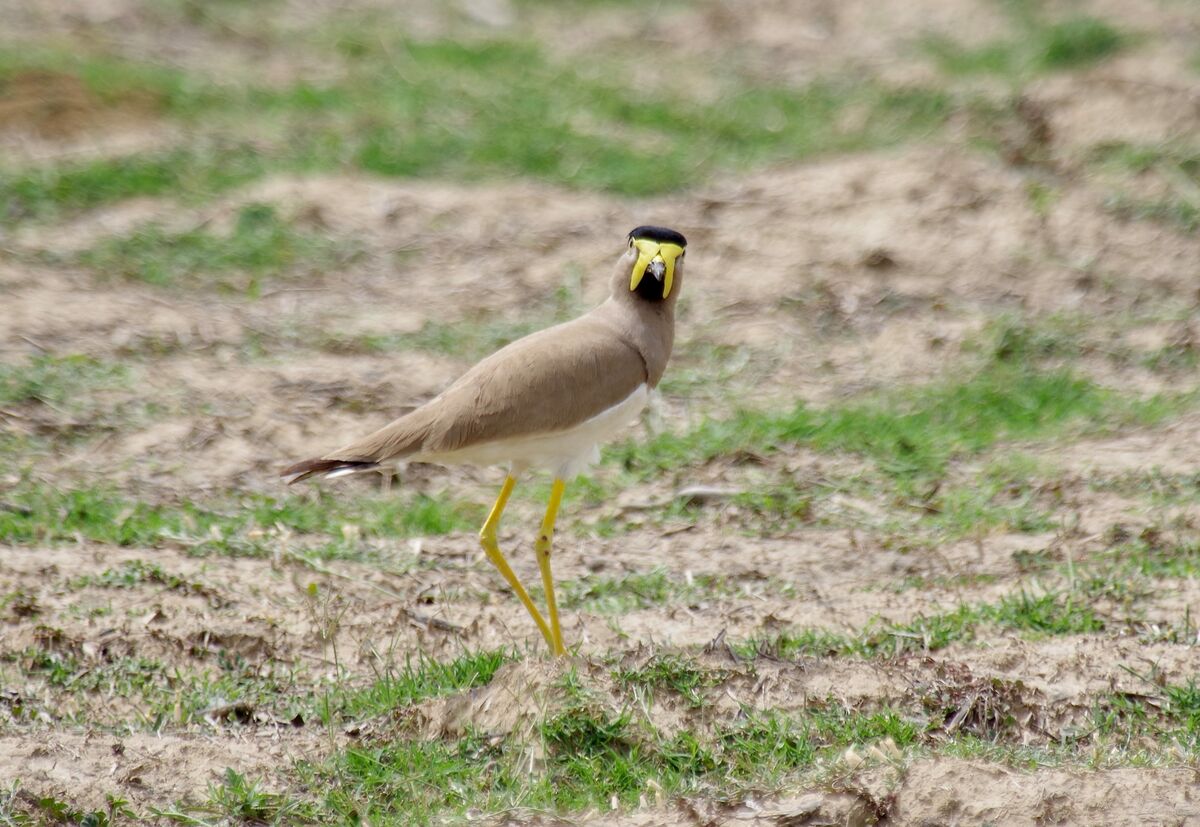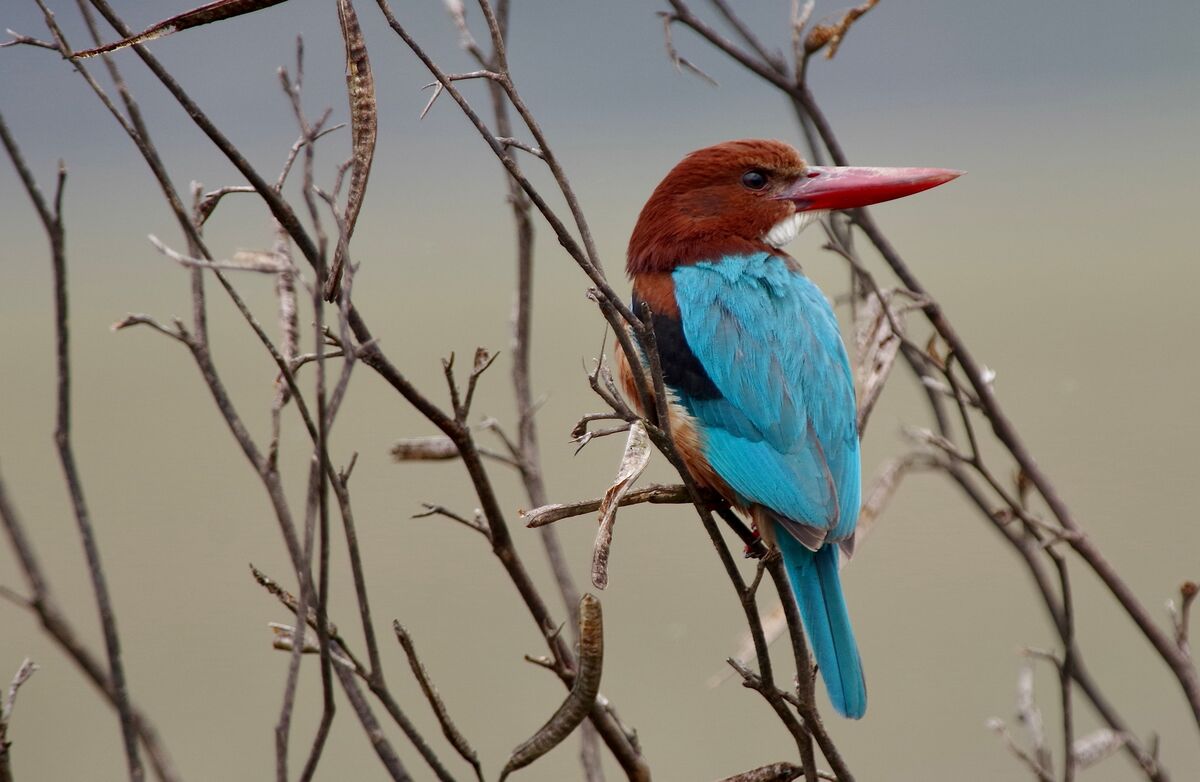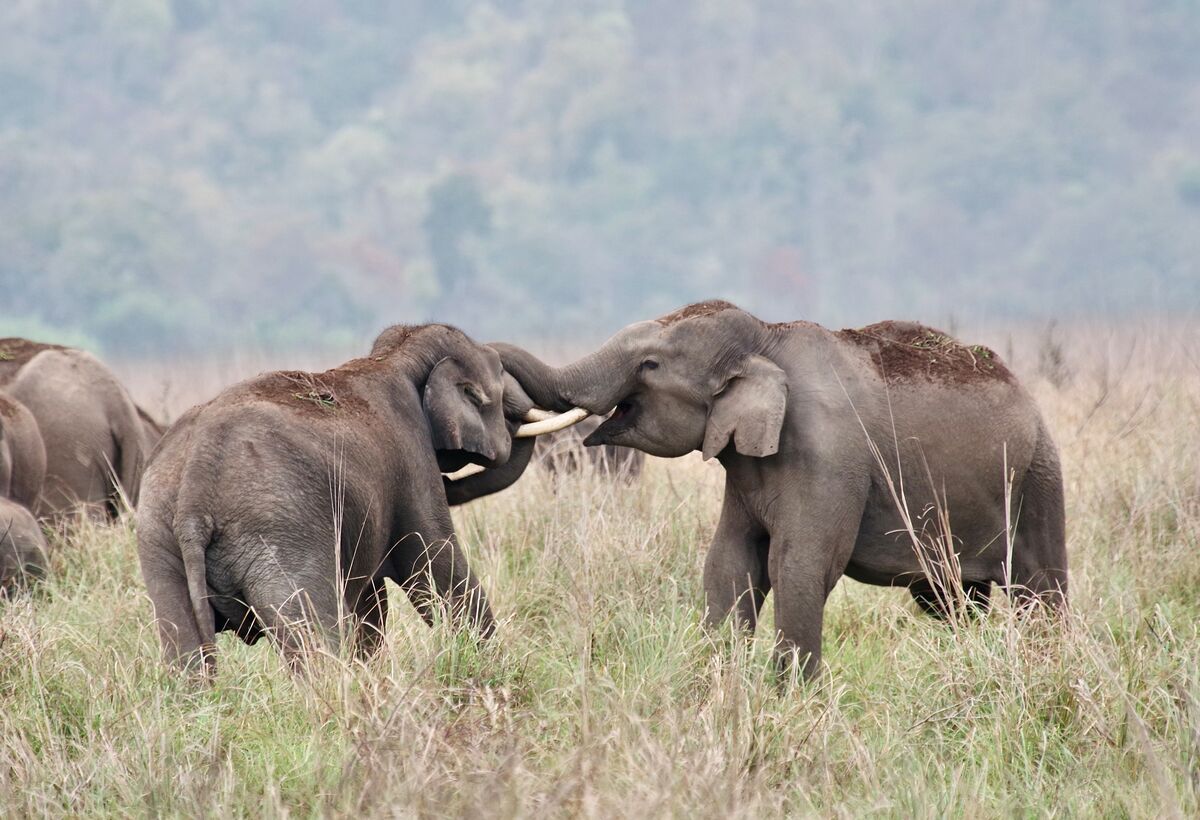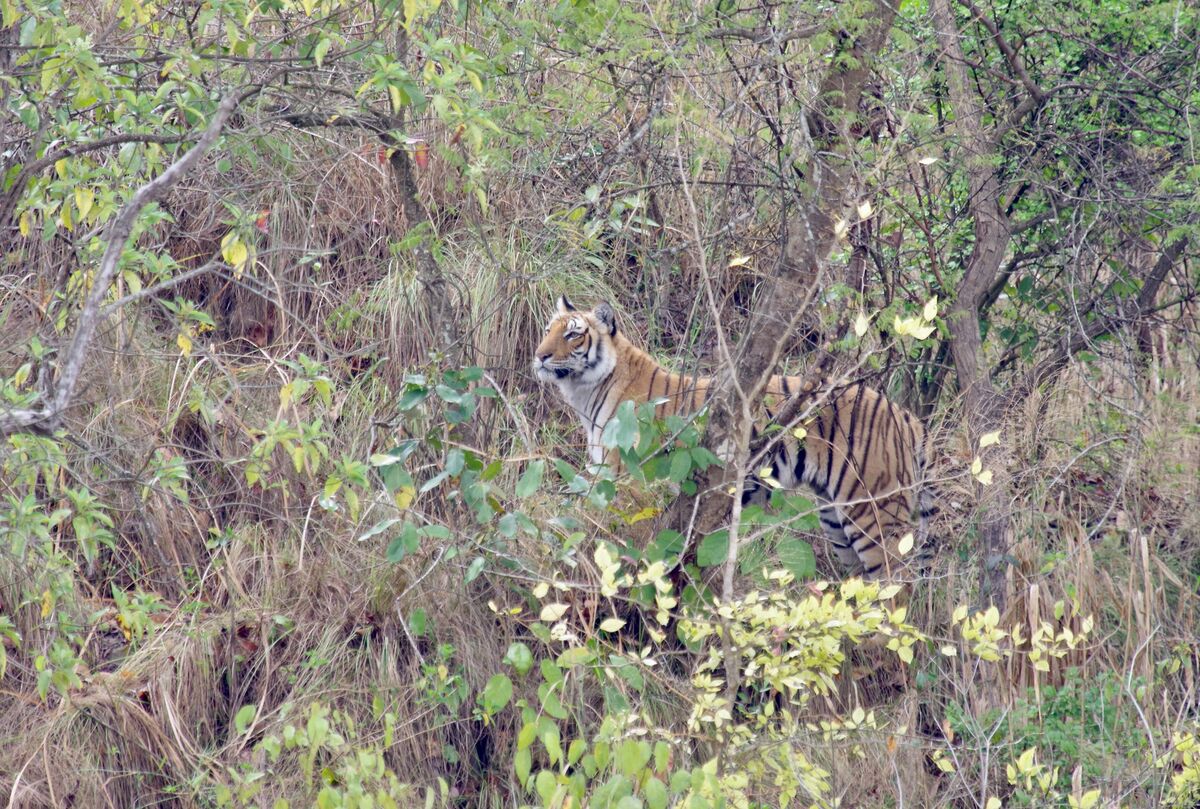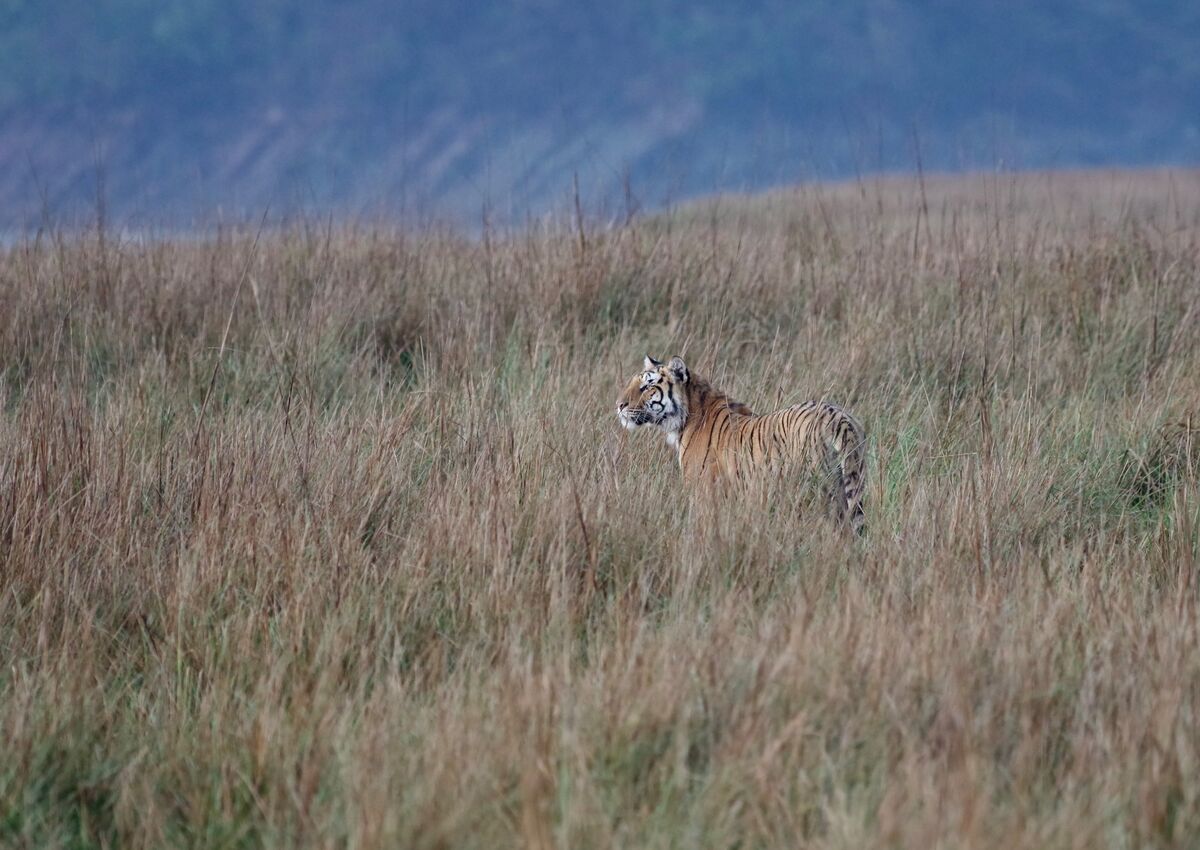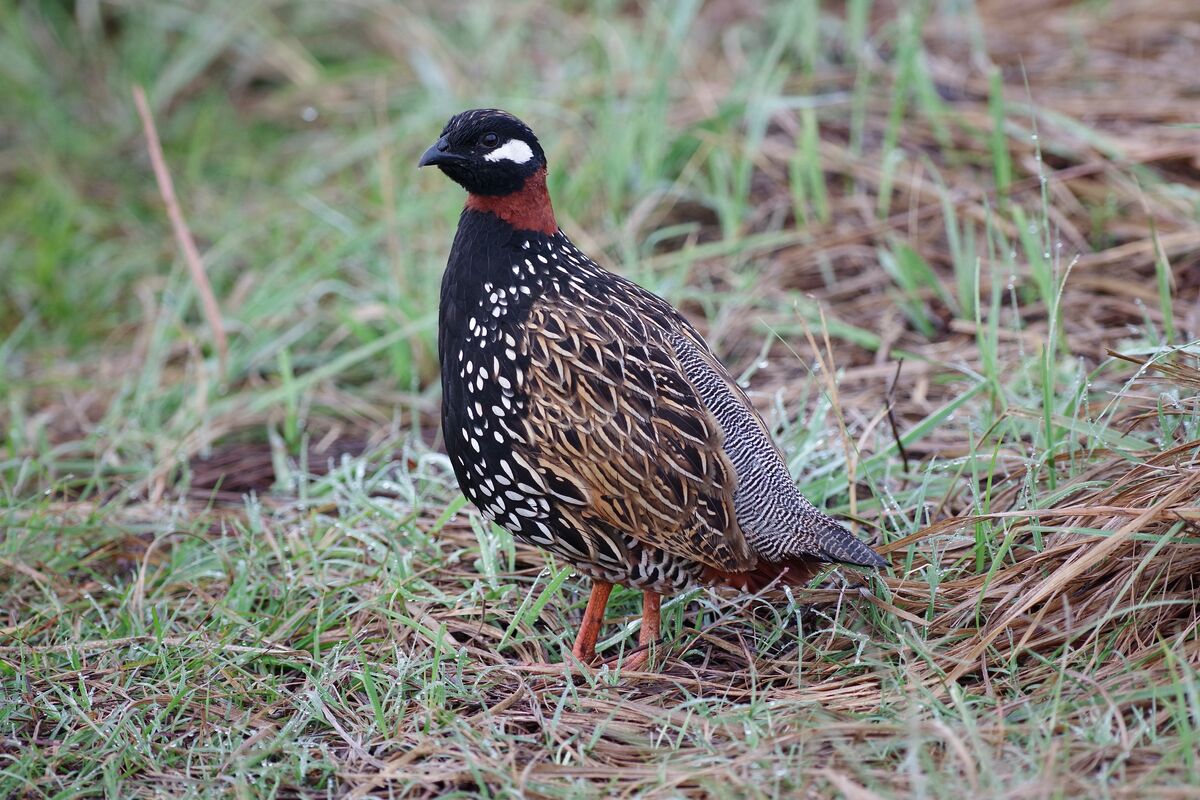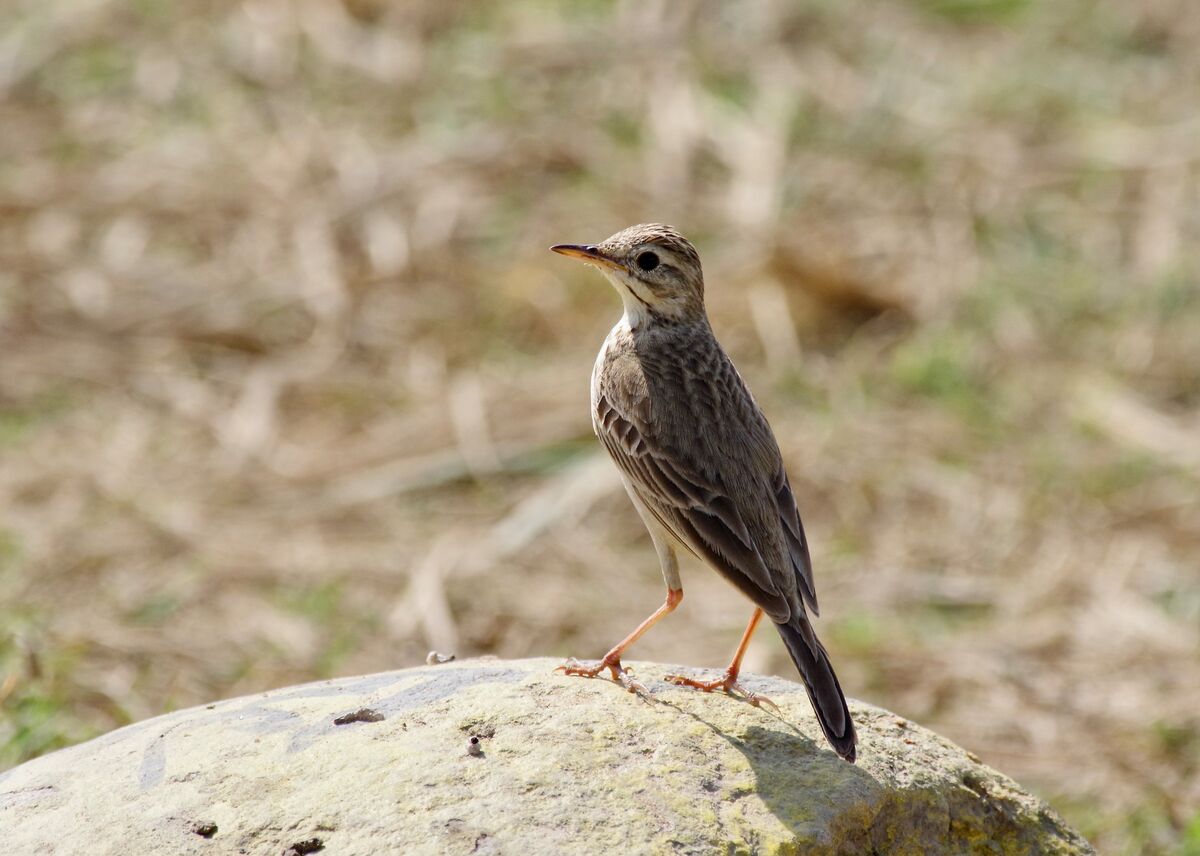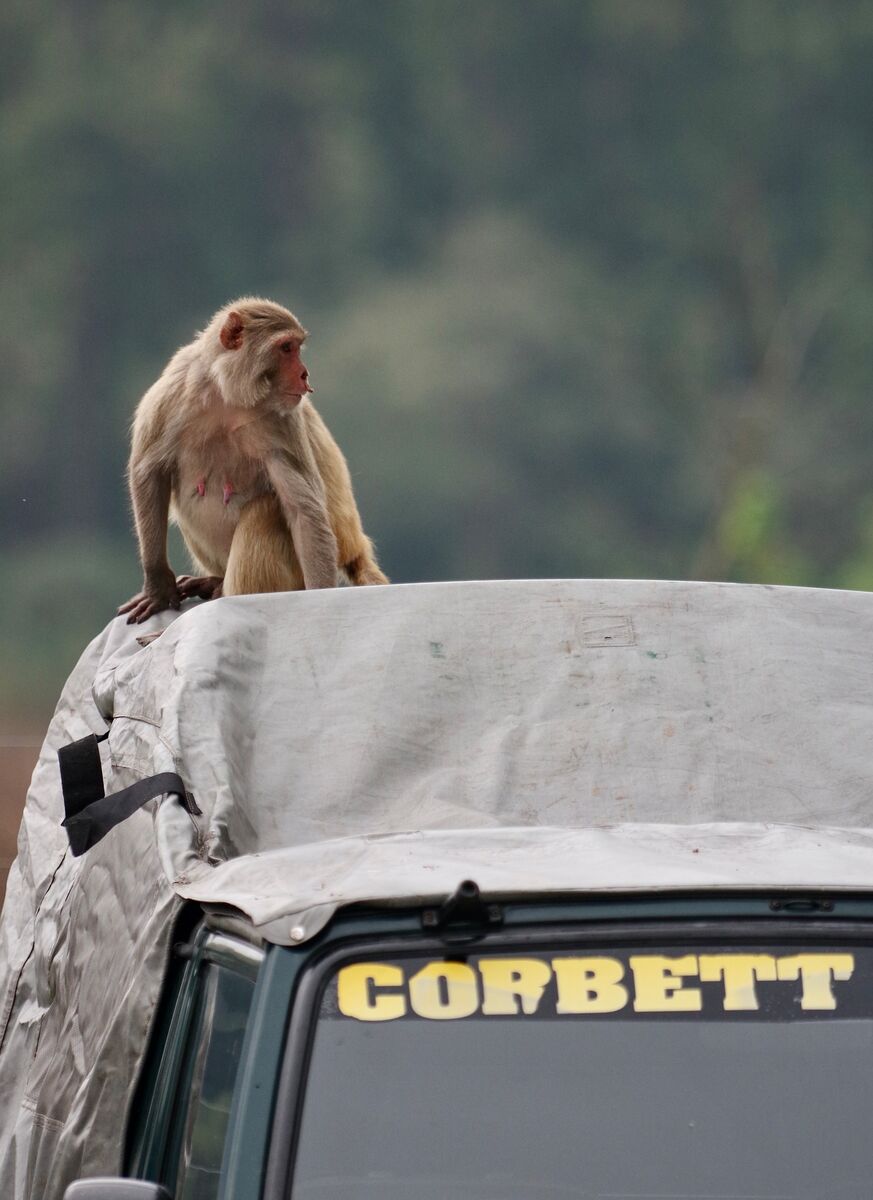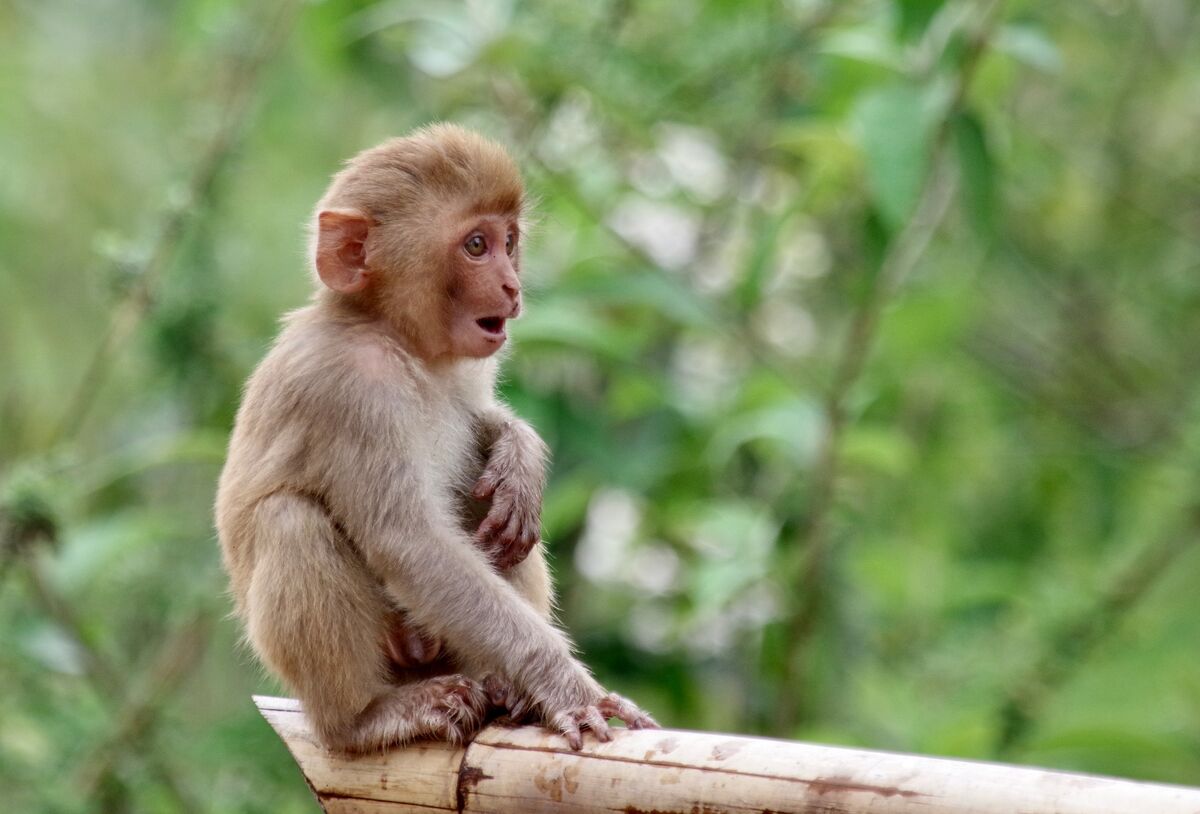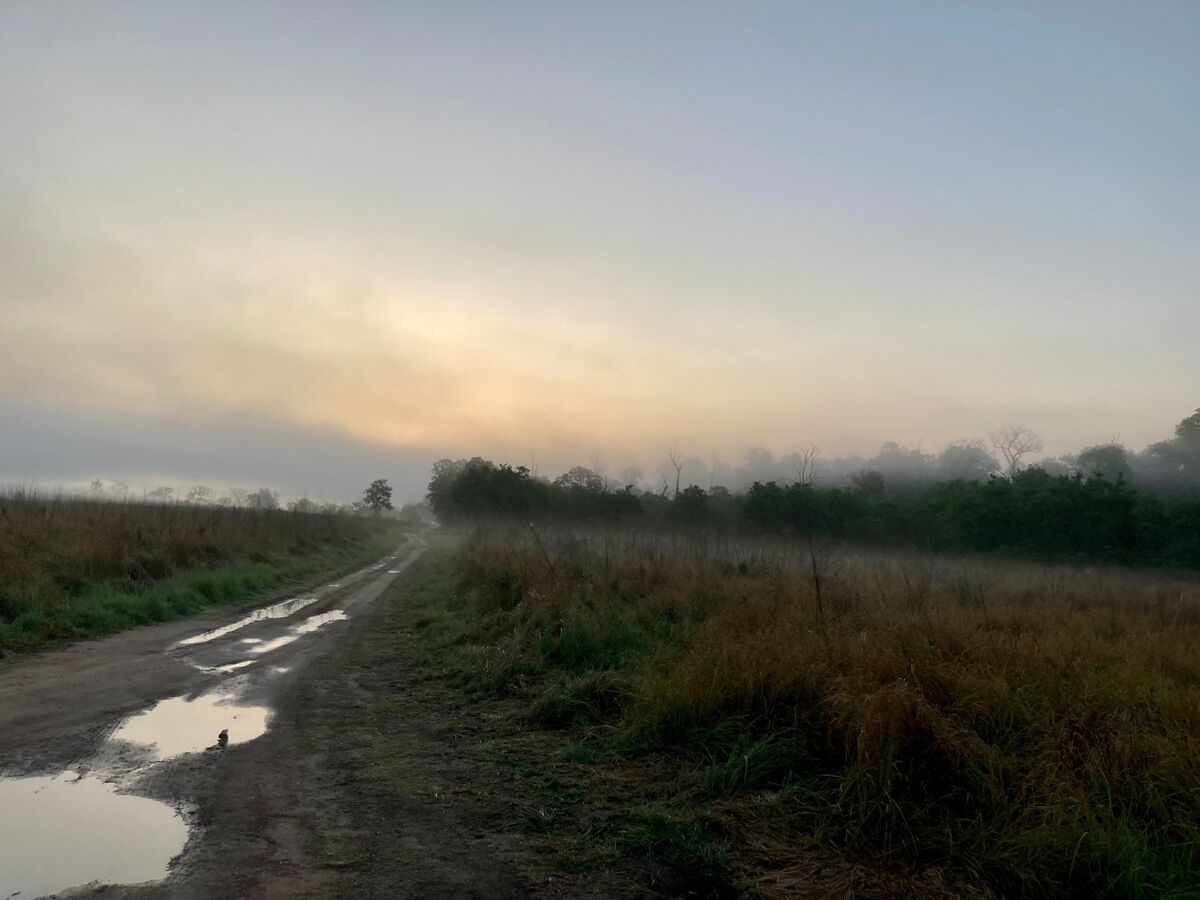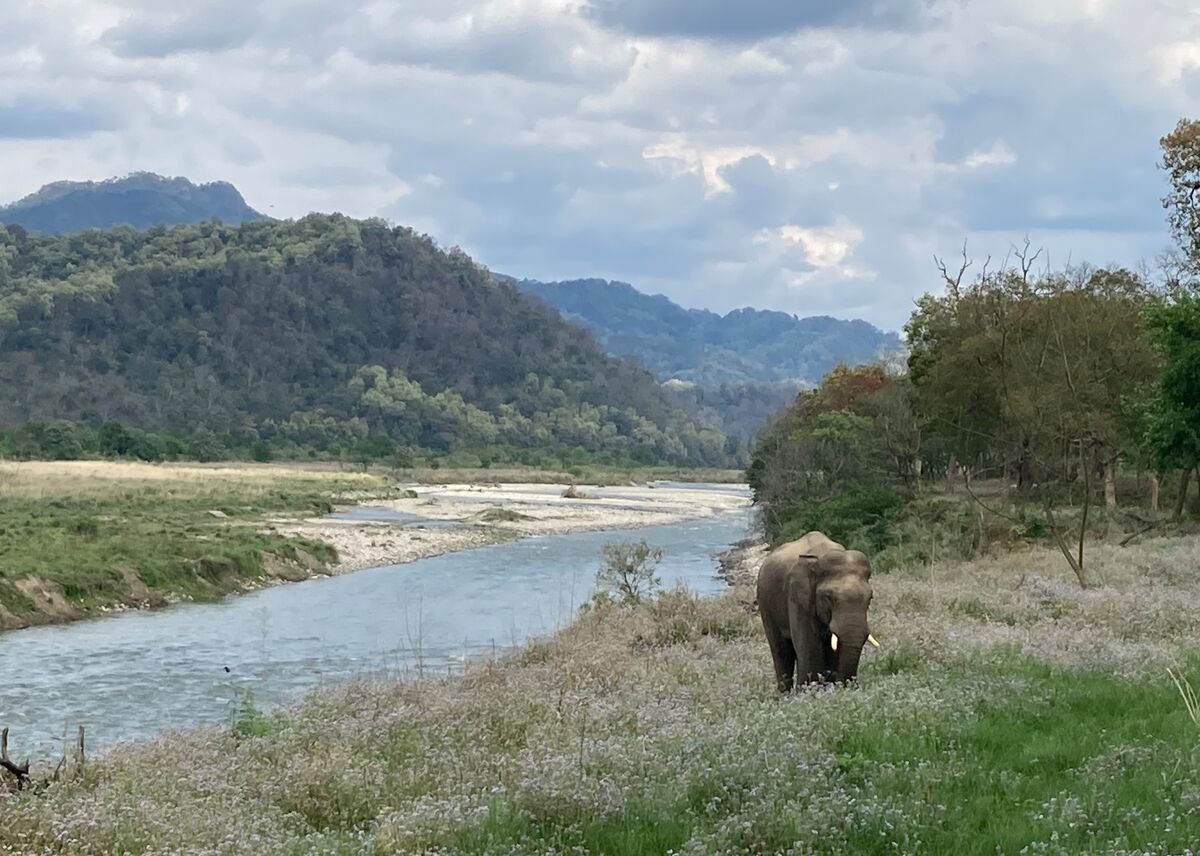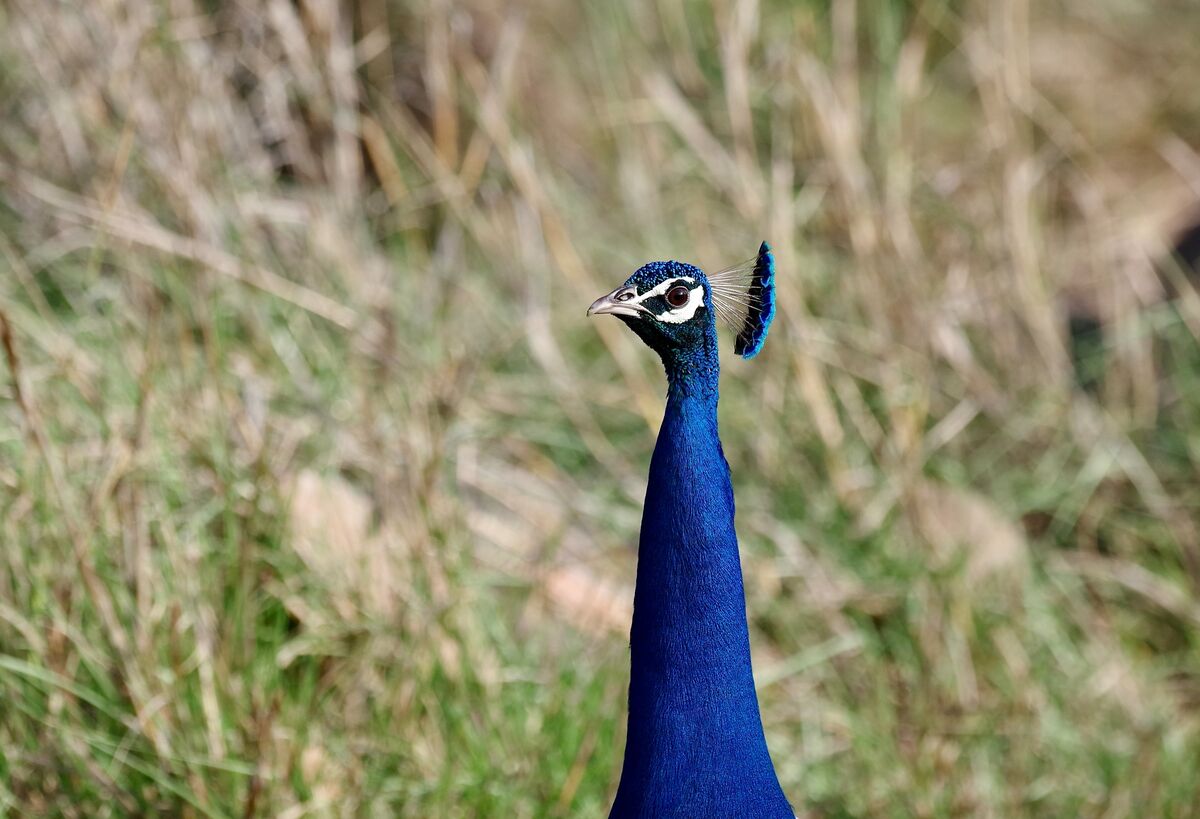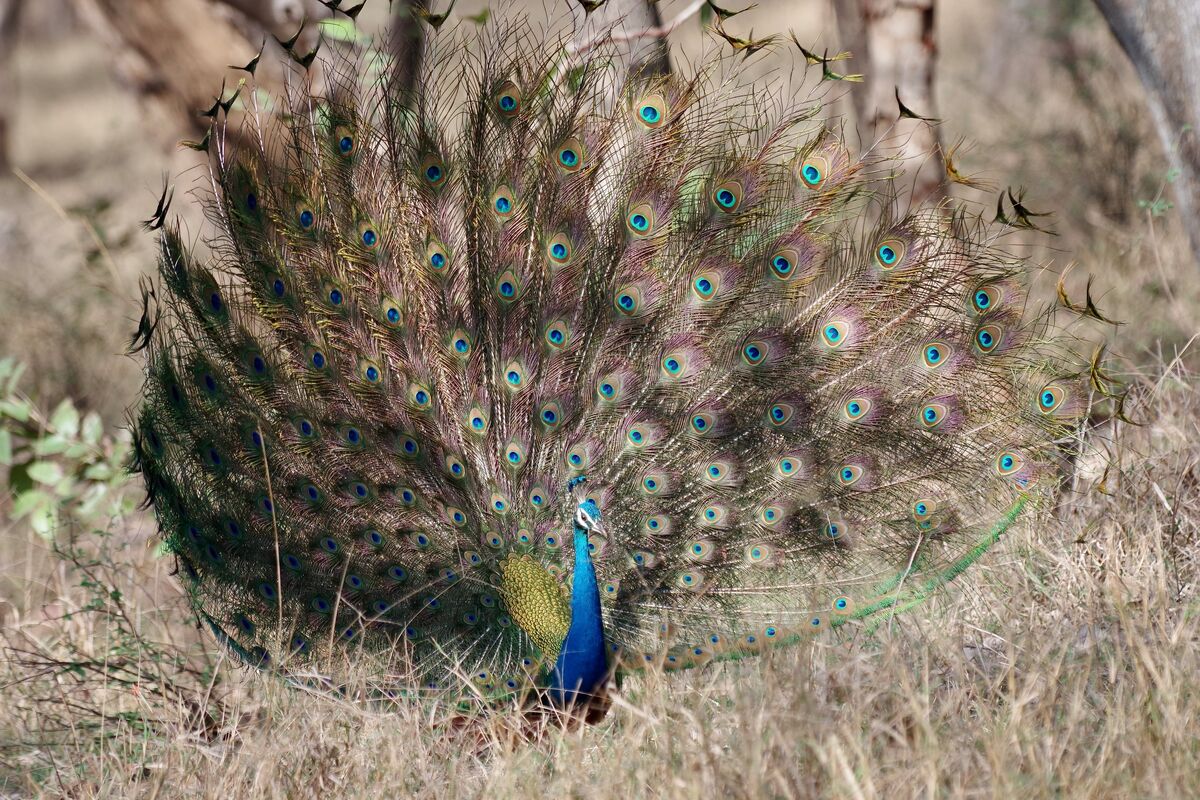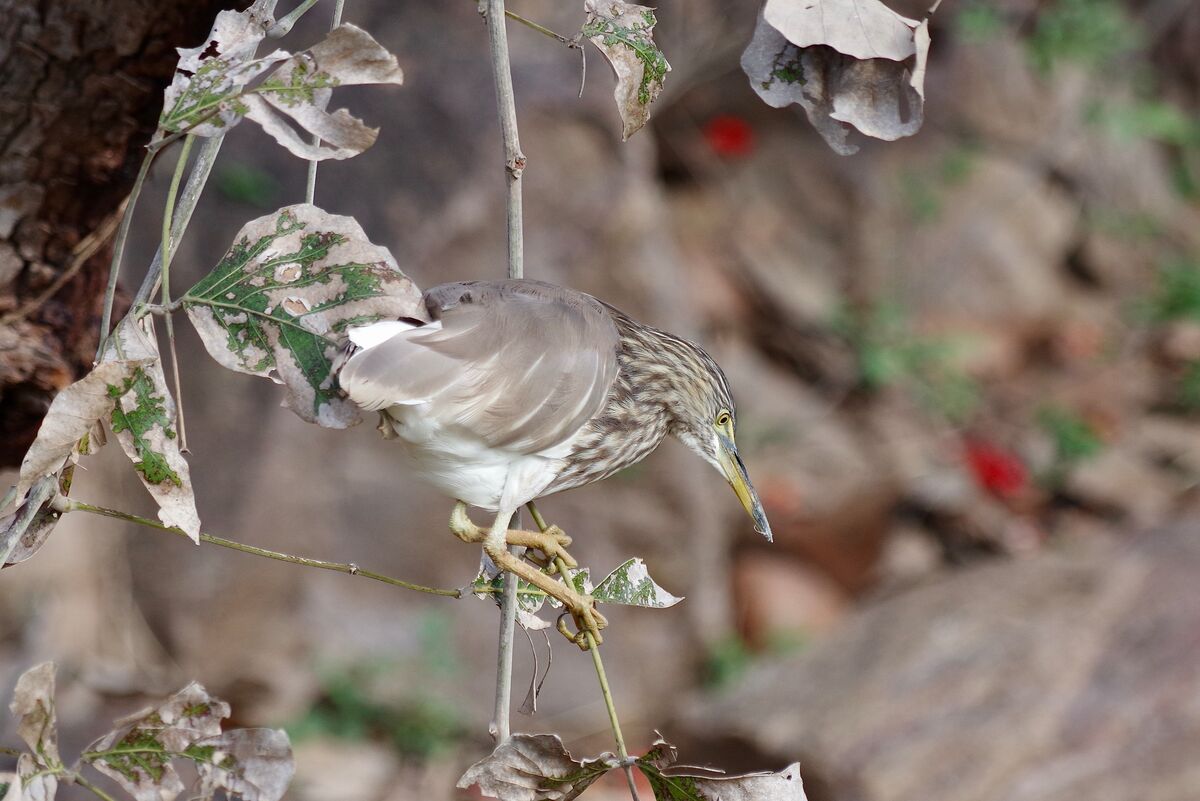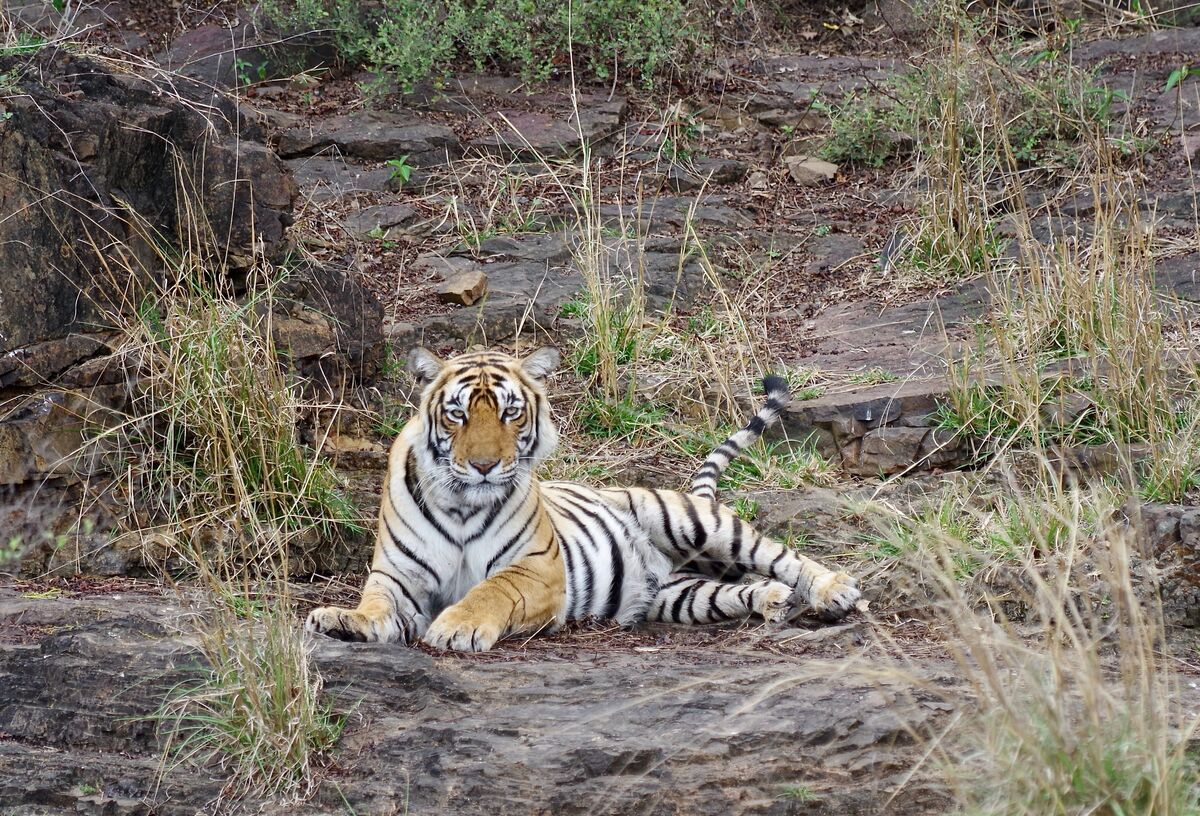Leif Rydell
South Vietnam 24-25
This Christmas/ New year I went to southern Vietnam with my wife for 2 weeks. We made a standard "classic" route including Ho Chi Minh city, Cat Tien National Park, Da Lat (mountain town) and 3 days by the beach. It was a good and comfortable trip and we took a private taxi between each place. Hiring a taxi is very cheap (Vietnam is cheap overall) and payed only 310 US dollars for the whole round trip. I have contact if you are interested. After spending the first night at an airport hotel, we head off to Cat Tien which is "the most famous" NP in Vietnam, possibly not only because of its wildlife but also its proximity to Ho Chi Minh. Her we stayed at the nice and well set lodge, Green Bamboo. It's right at the river and in the mornings and evenings you can hear the Yellow-cheeked Black Gibbons sing. They are born blond but later turn black. Photo from restaurant.
We had 3 nights and (2 full days here) and I had booked myself in to the photo hides they have here. It's 40-50 US Dollars per day and if you want to see the Pittas and other elusive species, you have to do it this way. At the first hide I saw the Blue-rumped Pitta easily in the morning and also the stunning Siberian Blue Robin.
I spent about 3 hours in the morning and enjoyed several other species like Grey-faced Tit-babbler, Puff-throated Babbler, White-rumped Shama and the curious Ochraceous Bulbul.
Not only birds were hungry and a couple of N Smooth- Treeshrew and Pallas´s Squirrel also joined the food party.
A few ground living birds as the Germain´s Peacock-Pheasant and Scaly-breasted Partridge were also present from time to time.
As the heat became more and more intense I decided to leave without seeing the Bar-bellied Pitta, which made me quite disappointed. The last one to be seen at this time was the handsome Indochinese Blue Flycatcher.
I walked around the headquarters for an hour looking for "open areas" birds and saw a few. By the ticket desk I met the ranger who took me to the hide. He asked if it had been good and I answered yes, but no Bar-bellied Pitta. He told me the pitta sometimes shows up also in the afternoon and gave my a deal "half price" to go there after lunch again which Í accepted. So I went back to the river and took the boat to the other side and had a nice lunch. As agreed , I went back and again he followed me to the same hide. Just after 30 minutes it shoved up, a superb male of the Bar-bellied Pitta. What a great moment.
Next day my wife and I took a tour to Crocodile Lake with a local guide. We hiked through the jungle the last 3 km and enjoyed the scenery with several Crocks just next to the jetty. In early morning and late evenings, several Green Peafowls come out from the dense forest to feed. No one at this time though I walked the edge and tried to find one. When we came back to HQ my wife went back to the lodge and I took a walk in the other direction to see what I could find. To my surprise, a male came walking just in front of me. What luck!
The last morning I was booked in to an other hide with different species and the best place to see the elusive Siamese Fireback. Unfortunately, no one showed, but I still had a good collection of nice bird like this Slaty-legged Rail and Gr. Racket-tailed Drongo.
Two more Bulbuls, the Streak-eared and Stripe-throated also showed well several at times. Also here and a very shy Greater Coucal and a nice Hainan Blue Flycatcher.
The common Zebra Dove and the much shyer Emerald Dove flew in and back before I had to call it the day and return to the hotel for departure to our next place, the hilly town of Da Lat, where we also celebrated the New Year.
Except for beeing a popular spot also for Vietnamese tourists because of the flower festival, it too, has it share of good birds. I had quite a few good hours (no photos though) at the forest slope of Mt. Liang Biang. Very foggy and windy at the top but ok inside the forest itself. Our hotel at the northern side of town was also next to the forest and one of the few birds photographed here was the Burmese Shrike.
We had good days here and took a great full day tour to the surroundings, visiting coffee plantations and a very big female Buddha statue which we climbed all the way up inside it.
Our third stop during our vacation was by the sea, just south of Phan Tiet. Here we stayed at a nice resort for 3 nights taking swims in the ocean and some nice massages. At the beach I had a big flock of Sanderlings and a Great Thick-knee! I hired a cab for a half day and went south to a salt-work area where many different shorebirds and other wetland bird ha been reported. No good photos from here but well worth the trip. An other day I took a shuttle in to Phan Tiet to look for Vietnamese Greenfinch which had been reported. I was luckier here and saw 8 in total. In the garden of the hotel, a friend from home, the Eu. Tree Sparrow.
The last 2 nights went spent in Ho Chi Minh city. What a "crazy" place. About 11 million people and estimated 10 million mopeds/ vespas. They were everywhere and getting from one side to another of the street was a true challenge. Of course we took a mandatory day tour to the tunnels used during the terrible war and I ended up "sick" after visiting the museum. We also visited an island in the delta where people still live a simple life away from the big city. Vietnam is a very friendly country well worth visiting and also relatively cheap.
In total I got 34 new bird species and saw about 120 in total, which I believe is quite good taking in this was not a pure birding trip.
Northern Tanzania -24
For the 6th time, I was fortuned to visit the lovely country of Tanzania. It was 5 years since last time and it was great to be back. My close friend Robert, who is the Director of Kibaha school outside Dar es Salaam, met me in Arusha. My flight to Doha from Stockholm was late and I just managed to get my flight to Kilimanjaro by running through the airport. Therefor, I was not surprised to see that my suitcase was not at the airport to be picked up. I had to stand in a line and make a request before we could head on. Our plan was to spend some time together and also go on a shorter safari. In total, I had 8 nights and 4 of these I spent with Robert, who later had to visit a job conference in Dodoma. A 3 day safari with 2 days in Tarangire and one at Ngorongoro was in our itinerary. https://kilimanjaronaturetrail.com/ After this, I then spent 4 nights on my own at a lovely small lodge at the southern slope of Mt Kilimanjaro. First we went to Lake Duluti outside Arusha where we had a walk. The forest was very hard birding but in a more open field we had many species, among these this Taveta Golden Weaver (female), a flock of Speckled Mousebirds and also a flock of Blue Monkeys.
We then visited Kilimanjaro Golf club and had lunch. While Robert was doing some work calls, I took a walk around the empty course. I saw plenty of birds and among them, Af Grey Flycatcher, Hammerkop, Tawny-flanked Prinia, Winding Cisticola and a handsome Chin-spot Batis.
While having our lunch att the club house, I spotted a medium sized bird in a tree next to us. Great views of this Pearl-spotted Owlet.
Next day, Safari day. We got picked up by our excellent guide Nick (Nicholoas) who is working for the company we hired, Kilimanjaro Nature Trail https://kilimanjaronaturetrail.com/ . This company has good service and also priced in a more decent way than some of the others. We left early towards Tarangire NP. This was the first time for me to this park which holds plenty of animals and quite a few special birds you wont see in Ngorogoro or Serengeti. My super target bird was the Long-toed Lapwing, a shorebird not easy to see, except at special spots. Quite a long drive from the gate to Silale swamp we arrived and started to search. After a while I spotted one resting but the next 30 minutes gave 11 in total on a stretch of about 1 km. What a relief. Here also a stunning d'Arnauds Barbet. In the swamp next to the Lapwings one single Reedbuck was feeding.
For most people, East Africa means big mammals and go for the big 5. I have been so fortuned to do quite a few safaris and seeing these majestic animals are always a great pleasure. tarangire is famous for big herd of Elephants and Buffalos and we saw plenty the two days we spent here. Here some close up views of them as well as Blue Wlidebeests and the stunning Waterbuck.
At one of the picnic spots we visited there were of course animals trying to get lucky with all the food (waste) people "leave". This young Velvet Monkey was both curious and hungry as well as the local speciality, the Ashy Starling.
Just outside the picnic area I saw my only Rock Dassie, (which apparently is closest related to the Elephant!) and one of many N. White-crowned Shrikes.
We made a loop into a more drier area, called small Serengeti. Not that many birds around here but some of the ones I had hoped to see in this spot. We spotted a group of Black-faced Sandgrouses in the shadow of a bush trying to escape the upcoming heat. A softly patterned Double-banded Courser (a favorite) and a cute pair of Namaqua Doves.
A little bit further on we had good views of 2 Scretary Birds walking slowly next to our jeep. Close by under a tree a few Yellow-necked Spurfowls with a cute Dik Dik (the smallest of all antelopes). In a burnt spot several Fisher's Sparrow-lark with a Lark hard to identify 100%.
Tarangire is well known for its amount of birds not usually seen in the other national parks. Birds like Red-bellied Parrot is quite easy here while can be hard at other places. The more common ones are also plentiful like these Red-cheeked Cordon-bleus and Yellow-collared Lovebird.
Ngorongoro (crater) National park is totally different and sometimes described as Garden of Eden. Here, down at the bottom of and old crater from a collapsed vulcano, animals live in a true circle of life. Most of the animal (except birds of course) stay here all the time. The angle of the slope makes it impossible for Giraffes to enter, so therefor you will not see this magnificent animal here. The crater i about 16-19 km wide and is a stronghold for Lions, Black Rhinos, Hippos and many different types of antelopes. In total we saw 7 lions in two groups, both a a very close range.
One of the bird species I really wanted to see was this male Rosy-breasted Longclaw which was kind enough to show itself close to our car. Other birds that came up close was this Capped Whetear, Black-winged Lapwing and the handsome and colorful Agami Lizard.
One spot all the jeeps go to is the Hippo Pond. This is a great place to enjoy your lunch while looking at all the bathing Hippos. Some birds like it here as well and probably find parts of their daily meals along the picnic tables. Close up were some Superb Starlings as well as a local specialty, the Rufous-tailed Weaver.
Of course Ngorongoro has a lot of mammals, both on the slopes as these Olive Baboons as well as Zebras and playing Lions. In total I saw 17 different lions in Tarangire and Ngorongoro.
Just before we left I saw a group of Grey-crowned Cranes and a single Buffalo with some Cattle Egrets.
At the top of the rim you will have a stunning view of the crater. Some birds are present here as well, as this very local Mbulu White-eye. A pic of me and Robert as well.
After three wonderful (as always) days we now returned back to Arusha. Next morning Robert left for his meeting in Dodoma and I was picked up for at special bird trip. I have read about the Engikaret Lark Plain and what a terrific place it is for som dry/ arid species. My guide had not been here before as well but with help of Google maps we found the spot. This land is Maasai land but the Maasais here know about the fact that birders show up from time to time. One elder man followed us for the 3 hours I spent here. It was a very satisfying walk but very surprising I only saw one of several lark species normally seen here. Here the Fawn-coloured Lark of which I saw about 5-6.
Far from all birds I saw came close enough for photos but some of the more cooperative birds I saw was this White-browed Scrub-Robin and Fisher's Starling.
The area was mostly dry bush but one area closer to the Maasai water hole was greenish with some bigger trees. Here I saw some Eastern Violet-backed Sunbirds among plenty others. You can also see my guide from the tour operator of Kilimanjaro Nature Trail https://kilimanjaronaturetrail.com/ and the Maasai man who followed us.
Some animals can be spotted outside the parks and it's not unusual to spot Giraffes as we did next to the Lark Plain.
In good mood I left for my final destination on this trip. My guide now took me to the foot of Kilimanjaro where I stayed for 4 nights at the lovely Materuni Homes. First morning it was cloudy and no sight of the peak but next morning was very satisfying as well as the afternoon beer at the same spot. Here you can also visit a lovely waterfall and make Tanzanian local coffee.
I saw quite a few new birs but most of them in the forest next to the lodge. However, the enormous Silver-cheeked Hornbill, the Abyssinian Crimsonwing and the ever present Variable Sunbird showed well in more open country.
What a lovely country Tanzania is. It's well worth a visit for many reasons.
Namibia June 24
Namibia 24
Since many years, I have had a dream to visit Namibia. To see this vast land of sand, low mountains and bush with a very small population, was amazing. This summer I went with the whole family on a self drive trip with a big and reliable Toyota SUV. We made a "classic" roundtrip route from Windhoek. First we drove SW to a wine estate (one of 4 in Namibia) where we stayed for 3 nights. Here they have rescued 6 Cheetahs which they hold in a big refuge where they roam freely but need to be fed 5-6 days a week. We visited this place one evening and had close looks. From here we made a day trip to famous Sossusvlei, where the big, beautiful and very famous sand dunes are located. Next stop was Walvis Bay at the coast. Lots of good waterbirds. Further on we drove NE and stoped one night at a private range outside before we continued NE towards Etosha region. Etosha is a very famous national park. We didn't stay in the park itself (as you can) but at a very nice private range just SE of the eastern part, Gabus Ranch. After 12 nights we the drove south back to Windhoek for an evening flight back home.
Neuras Wine estate, where we stayed, is a small and remote place (in the middle of nowhere!?). Except for the Cheetahs, you can participate in wine tasting, walking some close and nice trails to look for birds. The trails held som goodies and among these the very local Karoo Scrub Robin and to my surprise a day active Cape Eagle Owl.
Here at the estate I also saw my first Grey-go-away-bird, African Red-eyed Bulbul which were very common in some places as well as the superb Crimson-breasted Shrike.
Second day here, we went for a day trip to the stunning areas of Sesriem and Sossusvlei. I wonder how many pictures that have been taken here by people from all over the word.
As my family climbed the dunes, I took an other direction. Main target bird of the trip was (is!) the local and declining Burchell's Courser which usually is seen here. I tried in many places but in vain. Not many birsd at all except for the (good name) Familiar Chat. I had great classic views of the Gemsbok (Oryx) at the top of the dune and also a lonely Springbok.
On the way out of the park we had close look at a pair of Ruppels Korhaan resting next to the road.
I woke up (as always when birding) early the last morning before we continued towards Walvis Bay at the coast. Neuras Wine estate in morning light. Just when we where driving out we encountered a family of 6 Surikats. Absolutely amazing, cute and curious animals, what a finish of the first place in our plan.
This drive was the most strenuous of them all. All the way except last 40 km on more or less rough roads. Some surprisingly bad concerning the fact this road is the shortest from this part towards the coastal town of Walvis Bay and Swapkopmund. Anyway, we had a good experience with some "classic" desert views as these Lappet-faced Vultures together with a Black-backed Jackal and some Pied Crows. Also passing the Tropic of Capricorn. 
After many hours of driving, we eventually reached Walvis Bay where we stayed at a very small and nice hotel right by the southern shore of the down. Here we had great views of the sunset with Flamingos at the front.
You don't need to take this route if you want to proceed north towards Etosha N.P. and the Caprivi Strip but as it is always great to feel the "sense of the ocean" and also a great place for some special birds, this was a must for me. I think Walvis Bay has the biggest colony of flamingos in the world with approximately 40.000 present divided in to same amount of Lesser and Greater. At decently close distance, it is easy to separate them. The Lesser with all sark bill and obviously smaller next to Greater. Here a few picks of them.
As I truly love the shorebirds, the second one possible on this trip, was the Chestnut-banded Plover. The salt pans just south of Walvis Bay is also a heaven for other coastal birds and usually a few Chestnut-banded around. The area is not small so you have to drive around and also the tide can make a difference how you will see them. I was quite far out on the strip when I saw the first ones. Really cute and at a good distance.
Here I also saw the (inland?!) subspecies of the White-fronted Plover, Pied Avocet and Black-winged Stilt.
Beside all the shorebirds, quite a few terns and gulls were here as well. Among them, the near threatened Damara Tern. Just next to them a couple of our largets tern , the The Caspian, were standing and and made the size difference very obvious. Also a few Great White Pelicans were hanging around.
Just by the hotel I saw some smaller passerines, among the the local Orange-river White-eye and the Common Waxbill.
Time to leave, we now headed NE. We had booked a private lodge just outside Omaruru. The lodge, Otjohotuzo Guest farm is strongly recommended, if you pass here and need a stop. We made a great Sundowner safari with absolutely awesome vistas of the surroundings. I also hade some nice birds here, among them the Pririt Batis, male and female, one of a few Sabota Larks and several Yellow-bellied Eremomelas.
We could have stayed an other night at this magic place but our itinerary forced us to continue NE. Our destination this time was our next Lodge, Gabus Game ranch where we stayed for 4 (5) nights. I chose this place though not in Etosha because of other important possibilities as horse riding among Giraffes, Wildebeest and antelopes. Nice place with free walks and good food. A great thing was the fire they lightened just before dark just by the lit waterhole. I filled up my list with new birds like this Fork-tailed Bee-eater, Burnt-necked Eremomela and the very common White-browed Sparrow-weaver.
Just by the lodge there was a water tank which attracted many different birds like Chestnut- and Golden-breasted Buntings, Blue Waxbills, Rosy-faced Lovebirds and some "francolins/ spurfowls" like these Red-billed Francolins.
Quite a few bigger animals roam freely around the property, amon them the stunning male of Waterbuck, Blue Wildebeest (Black also present) and the quite rare Hartebeest.
Walking around the property was great and relaxing as quite a few birds were present and som very common like the Southern Yellow-billed Hornbill and the ever present Fork-tailed Drongo.
A few "brownies" were present as well like the Rattling Cisticola and the Black-chested Prinia.
A highlight here is to sit by the evening fire, looking at birds and animals coming in to the waterhole. A superb way to end a day.
A stop in the middle of "no where"? trying to find a toilet.
Going to Namibia means going to Etosha. The N.P is world famous and very big. We only visited the eastern park as our guide (yes we didn´t drive here as many do but it showed to be vise as he new how to handle timing and spots). We went here for 2 days and stay at a very fancy lodge just outside the gates as driving back to Gabus would have been stupid. I've been lucky to participate in quite a few safaris now but it's always a great thing to do. Etosha is a dry park with i huge salt pan covering a big area of the park. It holds 4 out of 5 "Big 5". Af. Buffalo is not here as it needs wetter areas. You wont see any crocs either.
Plenty of Elephants though, we saw probably about 150 in total. Lots of Zebras, Impalas, Giraffes and Greater Kudus.
In Esosha there are several "waterholes" for people as well. Here you can have some food and visit toilets. On the lawns you will have no problem finding the (in good light) colorful Burchell's Starling.
All animals are not big and easy to spot. We had some very nice views of the smallest of all antelopes the DikDik and a curious Yellow Mongoose.
Etosha is also home to some special birds which prefers the dry habitat. Species like sandgrouses and bustards occur. I only saw one species of sandgrouse and 3 of bustards/ korhans, this Namaqua Sandgrouse, Red-crested Bustard, N. Black (White-quilled) Bustard and the largest of them all, the Kori Bustard.
More dry country birds include the stunning Lilac-breasted Roller, the most common FC the Marico Flycatcher and the Af. Gray Hornbill.
All big cats are present and we saw about 8 lions (resting in strong evening sun), one Leopard walking at semi distance and a mum with cub of Cheetah too far for a decent photo.
A superb look at the enormous Martial Eagle at the same waterhole as this Blacksmith Lapwing and cute? Warthog ended the day.
Well, everything has an end and it was now time for us to drive back to Windhoek and take an afternoon flight back home. Great trip to a very special and in its own way, a very beautiful country.
In total I saw 132 birds which is a modest number for 2 weeks in Africa but have in mind it is a arid country and this was as much a family trip. I also saw 24 different mammals which is quite good.
You can see all the birds at my profile on Ebird (Leif Rydell)
Colombia Feb 24
Again, I had the fortune to go on a birding holiday with my friend Nick Armstrong from England. By now we have been to several destinations the last 10 years. After having successful trips to Brazil and Argentina, we now decided to go to Colombia which is the country in the world that hold most species (about 1905 species last count). As time was limited for me we had an intense 12 days trip including 2 travel days and days travelled were Feb 16-28. We decided to visit the western Andes around the cities of Pereira and Manizales. Here there are some of the best places in all of Colombia and not very far away from each other. We visited fabulous Montezuma Lodge, Rio Blanco, Termales del Ruiz in Los Nevados NP and finally Tinamú lodge.
We were picked up by a pre-booked driver who took us for a 4 hour drive to Montezuma. It's a lovely spot at the edge of the national park and is runed by a mother and her 4 daughters. The mother was a birding pioneer and succeded in preserving the lodge as an oasis for birding enthusiasts. Yesenia who was our guide is very skillful in the birds as well as very polite. Highly recommended if you go there. Here's a picture from a Colombian magazine showing the family (Yesennia to the right) and a pic from the dining area at the lodge.
The lodge itself is situated close to a river which holds some really good birds but also the lawns and feeders by the lodge offer lots of birds, especially loads of hummingbirds. A total of 30 different hummingbirds through the year are possible. Here a fabulous male of Violet-tailed Sylph, two Collared Incas and a couple of White-necked Jacobins. Last one is a Rufous-tailed Hummingbird, which can be seen widely in central and south America.
Visiting Montezuma means you will need a local guide and transport as more or less all birding, except in the direct vicinity of the lodge, is made from the road that leads up to the top (military base). Each area has its specialties. At the top there are a picnic table and a few feeders. here you can enjoy fabulous views of the mountains and some special birds. Here a few Chestnut-bellied Flowerpiercers, Andean Emeralds, Tourmaline Sunangels and Green Honeycreepers occur. Also a stunning view of the mountains and and a photo of me, Nick and our fantastic guide Yesennia.
On the way down toward the lodge we did several stops and saw Municique Wood-wren, several Cinnamon Flycatchers, a nice W Ornate Flycatcher and the rare Gold-ringed Tanager.
At one stop we saw one of my targets, a Hooded Ant-pitta. Ant-pittas are a fabulous group of birds, very secretive and hard to see but can responde to play-back and also visit special feeding stations with worms.
Along the road town towards the lodge you will make several stops. Your guide will know where and they also have a few platform with one or two feeders. Not a bird but a magical sighting was this mini wasp colony of small nests. Not more than one cm and "glued" under one of the picknick tables. Also an awesome "glass-winged butterfly" with transparent wings and the near-threatened Purplish-mantled Tanager.
A few more of the birds seen on the way down were this rather rare Yellow-collared Chlorophonia (bad pic), Southern Emerald Toucanet and a female Green and Black Fruiteater.
 Our driver and us resting as well as a short walk in pure rainforest and an extremely small orchid as well as a curious Green-crowned Brilliant.
Our driver and us resting as well as a short walk in pure rainforest and an extremely small orchid as well as a curious Green-crowned Brilliant.
Back at the lodge we continued to enjoy the fabulous surroundings with more birds as this Black-chested Jay which they took care of a year ago after a raptor incident. Next hummingbird is a female of the Violet-tailed Sylph. You would easily think it's a male concidering the bright colours but sometimes the females also are stunning. An other easily seen gem is the Green Thorntail, female and male.
An absolutely stunning bird is the easily seen Velvet-purple Coronet. How could these colours be for real. Still, photos do not show all variations.
Me and Nick leaving for next great lodge, Rio Blanco.
Rio Blanco natural reserve is just outside the town of Manizales. The lodge itself is located at around 2500 meters and you walk up to 2800 during your visit. This lodge is famous for having 5 differnt Ant-pittas coming out for worms at special feeding stations. It's quite a spectacle as the guides call them by their given names and they have adapted to special times during the day when worm are served. We managed to see 4 of them during our stay which feels good as rain had made snails coming up from the mud and giving no actual reason to go extra for worms. Hera you can see Bicolored Antpitta, Chestnut-crowned Antpitta, Slaty-crowned Antpitta, and finally the rarest, the Brown-banded Antpitta.
Close to these feeders you well most likely encounter some other birds showing interest for the food. This male Green and Black Fruiteater came out many times as did the Gray-browed Brushfinch.
Below, one of the famous local guides doing everything he can to attract the Antpitta to show up.
Here, as well as most places in this country, hummingbirds are a major attraction. One of the star birds is of course the Long-tailed Sylph (very similar to Violet-tailed Sylph) seen at Montezuma. The most common one is the handsome Buff-tailed Coronet.
The smallest of them here at Rio Blanco is the Speckled Hummingbird, just about 7-8 cm. In some way even more amazing than the bigger and more sparkling ones.
I tried quite a few times to capture a hummer when flying which is a true challenge. One of the few results to show is this Brown Inca which I managed to "nail" on its way towards a feeder.
The last day we went for a walk downwards. Chance of many other birds we had good moments with the following birds: Sickle-winged Guan, Berryl-spangeled Tanager, Barred Becard and Andean Motmot.
A few pics of the lodge itself and the surroundings. In the evening, people who stays overnight, gather in the small restaurant and enjoy hospitality and a lot of moths.
 After After 3 nights here we continued towards Hotel Termales del Ruiz which is situated at 3500 m in Los Nevados NP. Our driving guide Ana Lucia Londono once again came a picked us up. On the way up we stopped at a hot spot for Noble Snipe, one of my targets. Unfortunately, a farm has recently been established here and no snipe was to be seen.
After After 3 nights here we continued towards Hotel Termales del Ruiz which is situated at 3500 m in Los Nevados NP. Our driving guide Ana Lucia Londono once again came a picked us up. On the way up we stopped at a hot spot for Noble Snipe, one of my targets. Unfortunately, a farm has recently been established here and no snipe was to be seen.
We continued to 4200 where the rare but local Buffy Helmetcrest was seen. This is a highly specialized hummingbird only to be found in this area and on high elevation. Photo below shows me, Nick and our good and enthusiastic driver, Ana Lucia, who took us from place to place during the whole trip. Down also a scenic picture of the vulcano at Los Nevados NP.
At this time I didn't feel much of the hight we were at but later on I had a strong reaction. When I went to Argentina a few years ago I also had problems but got rid of them whith some medical help and 20 minutes of oxygen. This time however, I didn't get any better though I tried to aclamtice to the hight. The following night was really terrible with strong headache and high pulse. Day time is easier to cope with and even we had to shorten our stay here to go lower down, we managed to see quite a few of the star birds here. Without doubt, the Rainbow-bearded Thornbill, is the true gem here. I never came close for a good shot but show it here because of its brilliance if you see it well.
There is a big feeding area here and it's easy to have splendid views of beauties like Scarlet-bellied Mountain Tanager, Lacrimose Mountain Tanager (2) and next to the road several Pale-naped Brushfinches.
Termales del Ruiz is also a "thermal hotel" with hot springs, giving guesst the opportunity to taake warm and relaxing baths during their stay. Several pools and the best food during our trip is definately worth mentioning. The most common (very common) of the hummingbirds is the very "aggressive" Shining Sunbeam (front and back).
Once again, the local guide shows the happening of the present Antpitta. Here Tawny Antpitta arrives every morning when the guide calls it by name. Slowly and quietly it approched for breakfast. Fantastic birds and always a memorable moment.
Not as frequent and strongly chased away by the Shining Sunbeams, were a few other hummer like this big and beautiful Great Saphirewing male sitting and female flying and the handsome Golden-breasted Puffleg.
Flowerpiercers are special group of birds with its semi-hooked bill. We saw 4 species during our trip and the Glossy was quite common here at Termales del Ruiz.
As told earlier, I didn't feel good at this high elevation and Ana Lucia had to pick us up earlier than planned. We stayed one night in Manizales before we drove towards our last place, the iconic Tinamu Lodge. This lodge is at lower elevation and boats different species. Climate change seems to make quite some changes and the amount of hummingbirds normally active around the feeders were completely absent. However, we saw many beautiful birds here as well. Inside the forest there are a few leks with the absolutely gorgeous Manakin and the handsome Green Hermit.
The owners of Tinamu have protected a rather smallish area of true forest and not far away from it you will find coffee plantations and other agriculture habits. Here you see the restaurants and how quick the plantations are.
Firsta night we went for a shorter night walk, hoping to see or hear some local owls. No owls but this Paraque was sitting on the lawn. Next to it a remarkable tree, which flowers open up during the dark time and close during day time.
At Tinamu there are several fruit feeders which in contrast to the hummingbird feeders, attracted several other species. The Red-crowned woodpecker was frequent as well as the Andean Motmot. Some other strange and special flowers seen were these below. Don't know the name of them though.
Birds are obviously the main attraction but this glassed shower/ bathroom in our room and the giant Guan Lizard were as memorable as many birds.
Last evening we spent the last hours on a terrace looking out through the beautiful scenery and having a well deserved beer. Also a picture of us and our excellent local guide and a happy meeting with the Moustached Puffbird.
Our plan included one more day at Tinamu but as we had seen most of the possible birds we decided to go to an other place before heading towards the airport, not far from Pereira, the Otún Quimbaya reserve which holds a few different birds from the places we have visited so far. Here we saw the rare Red-ruffed Fruitcrow (at nest) as well as an Andean Guan.
One of the absolute last birds we saw was this Bare-faced Ibis. Also one of the most commonly seen birds, the Great Thrush.
A great experience to visit this country but I must say, the hummingbirds are the biggest draw. Take care Colombia!!
India part 3, Tiger.
So this is my third and last part of the 38 days I spent in India. My plan was to stay one more week around Sattal after returning from the northern Himalayas. As my stomach was still in rather bad shape I felt I needed some change. Therefor I booked a flight to Goa which is a heaven for beach, party and Yoga lovers. As the beaches stretch more than 100 km, there are different types of places depending on what you want to do. I chose one just south of the airport which is very quiet. I just spent time here biking around and taking long walks on the beach. I had some problem with my lens so many photos were a no use. This Kentish Plover from my beach is one of only a few I could save. Fortunately I found what was wrong for the more important last days.
After 7 days in Goa I flew up to Delhi and was picked up by my driver for the first part, one day in Barathpur. My stomach was pretty bad this day and we had to make a stop at a hospital before continuing. The reason to go here was more or less only to see the Indian Courser. The park itself is not worth visiting this time as all migrants have left and the resident birds live a quiet life, so we went to a place about 10 km north of the park. To my big disappointment we never saw the courser. It had been there the day before and though we spent 7 hours here it never showed up. My guide told me this was the first time he hadn't seen it on this site!! I saw these two lapwings; the Yellow-wattled, the Red-wattled Lapwing and a few very shy Chestnut-bellied Sandgrouse but I have seen them all quite a few times before.
Next to a tree where we parked in the shadow, a group of Bank Mynas were searching for food in the rubbish on the street.
I the went back to Delhi to catch the night train to Ramnagar which is the main hub for the eastern part of Corbett. We slept a few hours before the jeep came and picked us up. For the next 4 days I was invited to stay and do safaris with 4 Indian fellows. 2 of them are doctors and one of the doctor's son also on his way to become one. The fourth man is working for WWF. Is was a great opportunity to go with them and my excellent tour operator had managed to find place in Dhikala zone which is the true hard core place for wildlife. Unfortunately, the government plan to close this fabulous place, so I can call myself lucky to have been there. Here you see all of us at the gate and a pic of the lodge area. On the way from the gate to the lodge, which is almost 1,5 hors drive in to the core area, we saw this roosting Tawny Fish-owl which didn't look too happy to see us.
Weather was much worse than normal for this time of the year and we had plenty of rain which made some of the safaris hard. A lovely moment was when the rain stopped in the afternoon and gave strong colours with the mountains and the grassy area. A stunning White-throated Kingfisher also wanted to enjoy the fresh air after the rain.
The grassy area was is a lovely place to see many elephants and Spotted Deers. Several "families" gathered here especially in the mornings and afternoons. We saw 2 bulls fighting which was a new experience. Here we also searched for and found the West Himalayan Bush-warbler which had been seen the day before. First record for this area.
The jeeps usually choose from the grassy areas or to go to the other side of the Kosi River. The river and its edges are popular sites for both mammals and birds. Here I saw my first tiger ever, which was a fantastic moment and a great relief. Now I had seen one quite far away resting and make small moves and could just hope to see one closer further on. As Shorebirds are my favorite group of birds this hour was one of the most memorable occasions, when we also spotted our first River Lapwing close up.
Corbett is well known as the oldest and biggest national park in India and also holds the greatest numbers of tigers of any park. The areas where tourists are allowed are just a fraction of the park itself. That combined with the vegetation which is very thick or covered in high grass makes observations hard. Not many people see tigers in Corbett, except for the lucky ones that makes it to Dhikala. My second tiger here was in high grass and we stood still for quite a while waiting for it to rise. One jeep had seen it for a few seconds and were pointing at the spot where it was resting. After almost an hour it rise and moved away. We had decent looks at it before disappearing in to the higher grass again. Here we also saw a splendid male Black Francolin, a proud Paddyfield Pipit and the ever present Pied Bushchat.
Monkeys are present at most places in nature habit and people are around. The seem to specialize in finding food in the jeeps. This guy (an old one and the baby one) liked to break themselves in to the jeeps during lunch breaks in hope to find some snacks.
As said before, rains were heavy a few times. Obviously, you will not stay at the lodge though raining. Time is precious during these few hours you have the opportunity. But it also meant some special moments according to nature. This Elephant and the drained track and dizzy landscape are examples of this.
Though I still had some severe pain in my stomach, thankfully reduced by help of my Indian friends I loved this part of the trip and even if we look happy here it was sad to leave this marvelous spot.
Anyway, time for the next and also last destination of the trip, Ranthambore NP. The trip there was made by train and once more I entered a night train, this time towards Jaipur where I had a half day before my afternoon train to Sawai Madhopur which is the town next to the park. Jaipur is famous for being one of the most beautiful towns in India. I hired a taxi for a half day and visited the most famous sites. Here a street view near the Water Fort, a pic of the big Amber Fort and a man at a local factory producing world famous hand made fabrics.
Ranthambore is perhaps the most "famous" tiger park in India. The fact that it is the closest one to Delhi, relatively open in nature structure for easier spottings and full of tigers make this park the hot spot number one. That means plenty of people! The good thing is that each zone (10 of them), have a limit amount of jeeps and canteens to enter. All parks in India have the structure that they provide two safaris each day, one morning and one in the afternoon. You always go back to your lodge/ hotel for lunch and rest for about 4 hours before going back in the afternoon. This differs from most park in Africa where you usually are out all day. This is a famous spot at one of the entrances whit winding roots around the walls. You can see a Peacock on the road. This bird is extremely beautiful and also very common in the park.
On my first safari I didn´t see tigers but it was during this first one I saw my only Sloth Bears. Two of them were looking for ants just by the track. They were moving constantly so getting a decent picture wasn't easy. This was the best shot I could get before they proceeded in to the forest.
In zone 2 where I saw the bears there are lots of smaller patches of water which attracts some birds. I had good views of this Brahaminy Starling which was a new tick and also of several Indian Pond Herons waiting for a catch.
It was not until my third safari I saw my first tiger here. Actually this individual was the only one I saw. Riddih is her name. She is about 4 years old and hardly a ridiculous creature. This first sighting was when she was resting at a cliff about 200 meters away. After about 2 hours she yawned 3 times and rose. Lucky for us she didn't go backwards but headed sideways. She disappeared behind a big rock but then came in to great views for about 30 seconds before disappearing in high grass. The last day we saw her again. She was walking slowly quite far away from us and we also had the sun in our eyes which made the observations rather difficult. I'm glad I had my binoculars (most people didn't as they just carry cameras), so I got to see her starting a hunt. She caught a big male Wildboar and the fight was very heavy. She dragged him in to the water and it took almost 4 minutes before you could see the desperate moves of the Wildboar stop. Great experience!!
As said before, it had rained a lot more than usual, which made the park much wetter than normally this time of the year. In April to June tiger sightings is more or less guaranteed but this year many smaller pools did not force the tigers to visit the bigger lakes. A very special bird is theh Great Thick-knee and we were lucky to see it up close with a chic which made the guide surprised. The Painted Stork was not plentiful but easy to observe as the always keep next to the shore of the lakes. 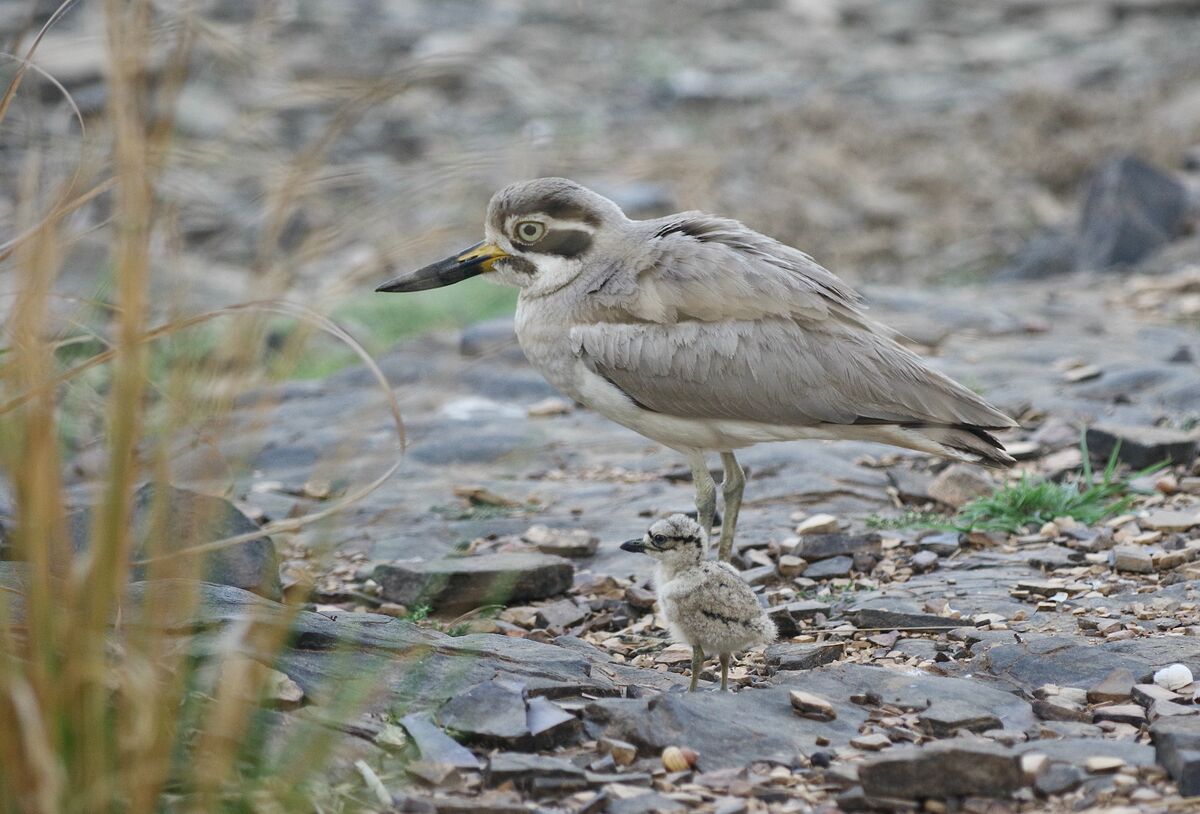
As the sun was getting closer to the horizon we stopped at the biggest lake with the fort at the back drop. Around here we had several Spotted Deers coming for an afternoon drink as well as this handsome Black-winged Kite. The last bird before leaving the park was this day roosting Indian Scoops Owl.
If interested in all bird sightings, you can check it up on my profile at Ebird. ebird.org (Leryd24, Leif Rydell)
Bye bye India!!






















































































































































